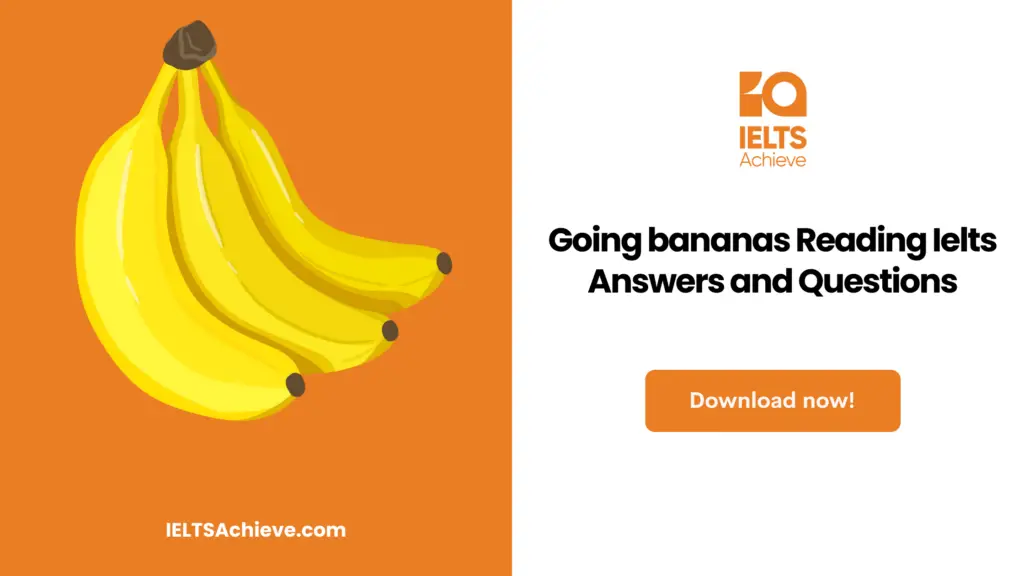The Blog post contains the following IELTS Reading Questions:
- IELTS reading sentence completion
- IELTS reading matching features
- IELTS reading true false not given
Stay informed and prepared for success – Explore our comprehensive Reading Test Info page to get valuable insights, exam format details, and expert tips for mastering the IELTS Reading section.
IELTS reading passage – going bananas

Going Bananas
Have you ever thought about the world’s favourite fruit disappearing forever in 10 years?
Banana is one of the world’s oldest crops. As per the agricultural scientist, it was believed that the edible bananas were first discovered around ten thousands years ago. Since its first propagation at the end of the last ice age in the jungles of South-Asia, Banana has been at an evolutionary standstill. Normally, Musa acuminata, a giant jungle herb is considered as the wild banana, that is virtually inedible as it contains a mass of hard seeds. However, hunter-gatherers were able to find rare mutant plants that had seedless, edible fruits. Genetics have discovered that, majority of these soft-fruited plants are a result of genetic accidents where three copies of each chromosome were produced instead of the two chromosomes. Due to this imbalance, the seeds and pollens are prevented from developing normally thus rendering the mutant plants to be sterile. This is the reason why some scientists are believing that the world’s most popular fruit could be doomed. The banana plantations in Central America and the small holdings of Africa and Asia are lacking the genetic diversity to fight the pests and diseases affecting them.
In certain aspects, the banana today is similar to the potato before the blight crop disease caused famine in Ireland a century and a half ago. But Emile Frison, top banana at the International Network for the improvement of Banana and Plantain in Montpellier, France, pointed out that “this famine has a lesson for other crops also”. Frison also warns “ The state of bananas is teaching a bigger lesson: the increased standardisation of the food crops around the globe is threatening the crop’s ability to adapt and survive in the environment”.
The sterile freaks are transplanted by cutting and replanting the plant’s stem by the first stone age plant breeders. And the bananas we eat today are the descendants of those original cuttings. Each plant is a near identical clone with a little genetic diversity. And this uniformity is making the bananas open for diseases like no other crop on Earth. It can noted that, crops that are sexually reporducing in the traditional ways, have a bigger genetic base and new genes will be developed as the genenes will be recoming into new arrangements in every generation. This will make them more flexible to the evolving diseases and has greater genetic resources to face an attack. But this advantage is fading as the growers are more interested in planting the same high-yielding varieties. To maintain the resistance in these standardised crops, plant breeders are working at a faster pace. If these attempts fail, even the most productive crop can easily extinguish. Geoff Hawtin, Director of the Rome-Based International Plant Genetic Resources Institute has pointed out that,” there may be a severe epidemic if there is a new pest or disease”.
The Banana can be considered a perfect example for this point. Until 1950, the banana variety Gros Michel was dominating the world’s commercial banana business. The Gros Michel was found in 1820’s by the French botanist in Asia and the variety is fine, richer and sweeter than the bananas we use today even without the bitter aftertaste we get when it is green. But this variety was easily affected by a soil fungus that caused a wilt known as Panama disease. Rodomiro Ortiz, Director of the International Institute of Tropical Agriculture in Ibadan, Nigeria said that” the fungus will remain in the soil for many years after entering. The farmers are not in position to clear them. Chemical spray usages have also proved useless”. Thus the plantation workers adopted the running game where they started abandoning the fungus attacked field for the clean land and abandoned the Gros Michel in 1950 as they had run out of the clean lands. Cavendish banana is the successor of the Gros Michel and is still the reigning commercial king after its discovery by the British in the 19th century from Southern China. The Cavendish have literally saved the international banana industry as they are resistant to the Panama disease. This variety replaced the Gros Michel from the supermarket shelves in the 1960s. The bananas we buy today are certainly Cavendish. Though it is still a minority in the world’s Banana crop.
In Asia and Africa, nearly half a billion people are dependent on bananas. The bananas are eaten daily as they are the largest source of calories. Bananas’ name remains synonymous with food. However the Cavendish and its indigenous kin varieties are soon going to be reckoning their day. Since its appearance in Fiji in 1963, a fungal disease named back Sigatoka, has become a global epidemic. The fungus causes brown wounds on the leaves and causes the fruit to prematurely ripening, thus cutting the fruit yield by 50 to 70 percent and decreasing the productive lifetime of the plant from 30 years to 2to 3 years. The black Sigatoka is kept at bay by the commercial growers with the help of massive chemical assault. Yearly forty sprayings of fungicide is vital for the plants. However the diseases like black Sigatoka are getting more intensified to be controlled by the fungicide. Frison mentioned “ with new fungicide, the diseases are also developing resistance” and “to be sure, black Sigatoka will not lose the battle”. Its effects are worse for poor farmers, who are not able to afford the costly chemicals. They can only watch their plants die of the disease. “Because of this disease, most of the banana plantations in the Amazonia have been destroyed” said by Luadir Gasparotto, Brazil’s leading banana pathologist with the government research agency EMBRAPA. He has predicted that the production may fall by 70 percent with the disease spreading. Discovering a new variety is the only solution available.
How? Is the important question. The growers are not able to just change the variety as all the edible banana types are susceptible to diseases. In the case of other crops, an army of breeders would scour the world for disease resistant relative breeds into commercial varieties when a new threat has begun. But the same doesn’t apply to bananas. This is because all the edible varieties have become sterile, thus bringing in new genetic traits which are resistant to pests and diseases are nearly impossible. This is nearly true but not totally. In rare conditions, a sterile banana can accidentally experience genetic changes, which allows them to develop a normal seed, giving a ray of hope to the breeders a tiny window for improvement. Breeders are trying to exploit this to produce disease-resistant varieties at the Honduran Foundation of Agricultural Research. A new seedless banana resistant to both black SIgatoka and Panama disease is being tried out by backcrossing the wild bananas. The new hybrid is not considered by either western supermarket consumers or peasant growers. This is because the bananas taste more like apples. Surprisingly, the majority of plant breeders have adopted to work on other easier crops than the banana. The commercial banana companies have started to lift their hands from the whole breeding effort and started to fund new fungicides inventions. “Though the investments are made on the breeding activities for the past 40 years, a replacement for the Cavandish is not yet identified. In spite of the huge cost investment, the returns from these are zero” quoted Ronald Romero, head of research at Chiquita, one of the Big three companies that conquer the international banana trade. Last year, the plans to sequence the banana genome in the next 5 years were announced by Frison in a global consortium of Scientists. This will be the first edible fruit to be sequenced. At Least nearly edible. Inedible wild bananas from East Asia will be sequenced by them as they are resistant to the Black Sigatoka disease. If they are able to identify the genes that make them resistant to the black Sigatoka, these protective genes may be cultured with the edible varieties in the laboratory. This will be later propagated to a new disease resistant variety and then given to the farmers. Though this seems like a good idea, big banana companies are ready to get involved in the GM project as they are fearing to lose their customers. “Biotechnology projects are highly expensive and the consumer acceptance rate of the hybrid products is still a question” pointed out by David McLaughlin, Chiquita’s senior director for environmental affairs. With very little funding, the banana genome researchers are trying to meet the end of the spectrum. Even after finding the crucial genes, implementing and developing a new variteity that smallholders find suitable and affordable has a long way to go. However, this is the only hope left for the breeders to save the banana. Without this, the banana production line in the world can head to a tailspin. Thus in near future, there may be an extinction of bananas as a life saver for hungry and impoverished Africans and as a popular product on the Supermarket shelves.
Unlock your full potential in the IELTS Reading section – Visit our IELTS Reading Practice Question Answer page now!
Recommended Questions:
Renewable Energy IELTS Reading Question with Answer
Going bananas IELTS reading questions
Questions 1-4
Complete the sentences using NO MORE THAN THREE WORDS from the passage for each answer.
- The banana evolution has been in standstill after its first propagation found in the _____________ at the end of ice age.
- The bananas are mainly consumed by Asians and Africans as they are the largest ___________.
- The new hybrid bananas are not accepted by the consumers or the commercial breeders as the taste is similar to ______________.
- Cavendish variety are under threat due to the fungal disease named ___________
Enhance your sentence completion skills in the IELTS Reading section. Click here to access our comprehensive guide and learn effective strategies for filling in missing words or phrases in sentences.
Question 5- 9
Write the appropriate letter on your answer sheet.
Note that there are more Observations than people, so you will not use all of them.
You can use each observation once only.
Use the information in the text to match the People listed (5-10) with the Observations (A-G).
Observations
- An alternative for the Cavendish variety is not found even after working on it for the past forty years.
- The banana plantations in the Amazonia are destroyed due to black Sigatoka.
- Viruses causing the Panama disease are remaining in the soil for years and are destroying the plantations.
- With the usage of new fungicides the viruses and pests are also developing their resistance.
- If new diseases or pests start to spread, a new epidemic will be caused in the world.
- Biotechnology projects are costly and the consumer acceptance rate is very low.
People
5. David McLaughlin
6. Laudir Gasparotto
7. Frison
8. Ronald Romero
9. Rodomiro Ortiz
Improve your performance in Matching Features questions by clicking here to access our comprehensive guide. Learn how to match specific features or characteristics with the options provided in the IELTS Reading section.
Questions 10- 13
Do the following statements agree with the information given in the reading passage?
Write
- TRUE if the statement agrees with the information
- FALSE if the statement contradicts the information
- NOT GIVEN if there is no information on this in the passage
10. Banana is the oldest edible fruit to be discovered.
11. Breeders are ready to start investing in other easier crops.
12. Bananas have the ability to develop disease resistant varieties on their own.
13. Black Sigatoka can be controlled using fungicides.
Enhance your skills in identifying information as True, False, or Not Given. Click here to discover expert strategies and techniques for mastering this question type in the IELTS Reading section.
Unlock your full potential in the IELTS Reading section – Visit our IELTS Reading Practice Question Answer page now!
Recommended Questions:
Renewable Energy IELTS Reading Question with Answer
Going bananas reading answers
| 1. Jungles of South-Asia | 5. Ronald Romero | 9. David McLaughlin | 13. True |
| 2. Source of calories | 6. Luadir Gasparotto | 10. Not given | |
| 3. Apple | 7. Rodomiro Ortiz | 11. True | |
| 4. Black Sigatoka | 8. Frison | 12. False |

We hope you found this post useful in helping you to study for the IELTS Test. If you have any questions please let us know in the comments below or on the Facebook page.
The best way to keep up to date with posts like this is to like us on Facebook, then follow us on Instagram and Pinterest. If you need help preparing for the IELTS Test, join the IELTS Achieve Academy and see how we can assist you to achieve your desired band score. We offer an essay correction service, mock exams and online courses.

